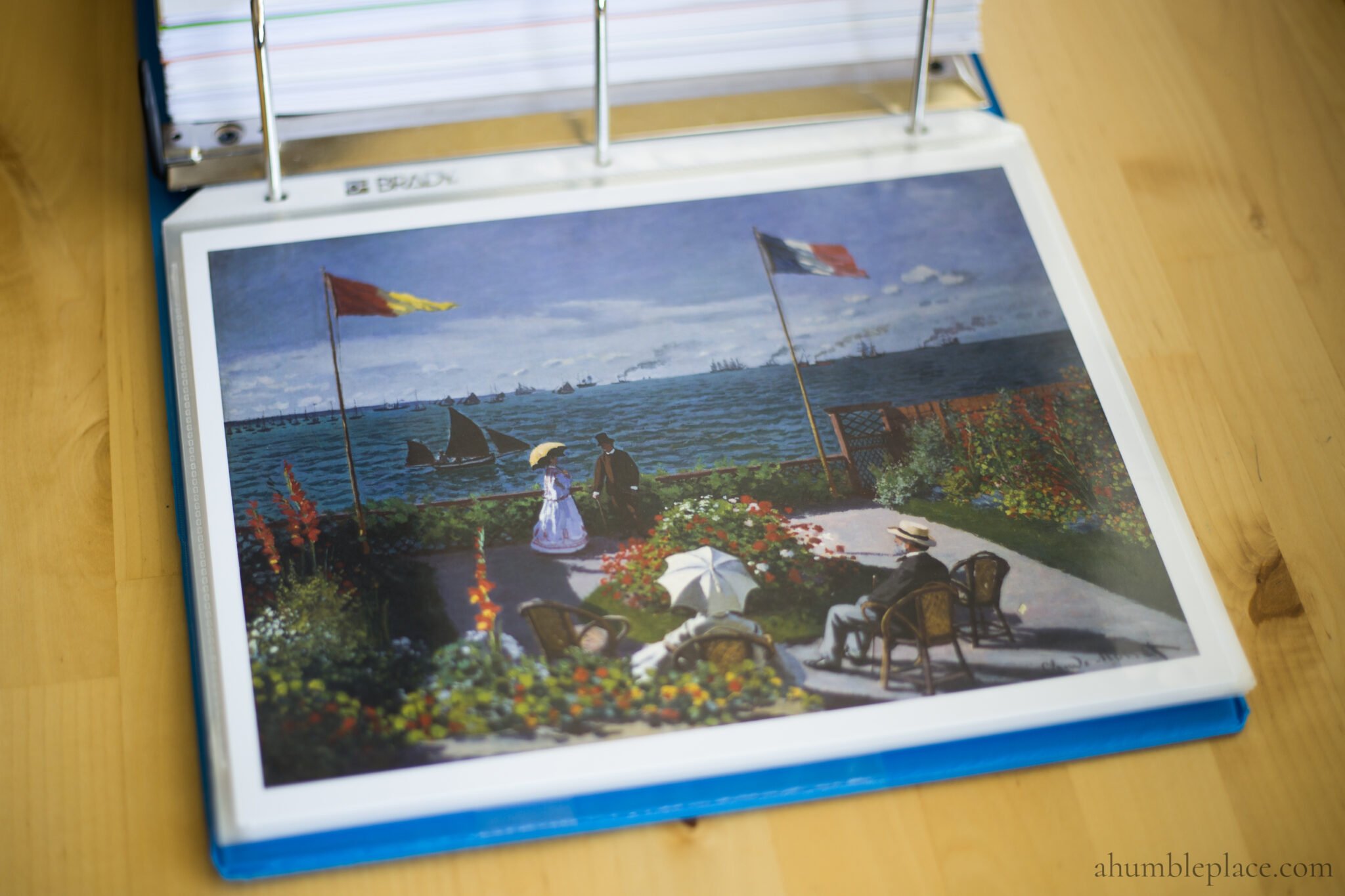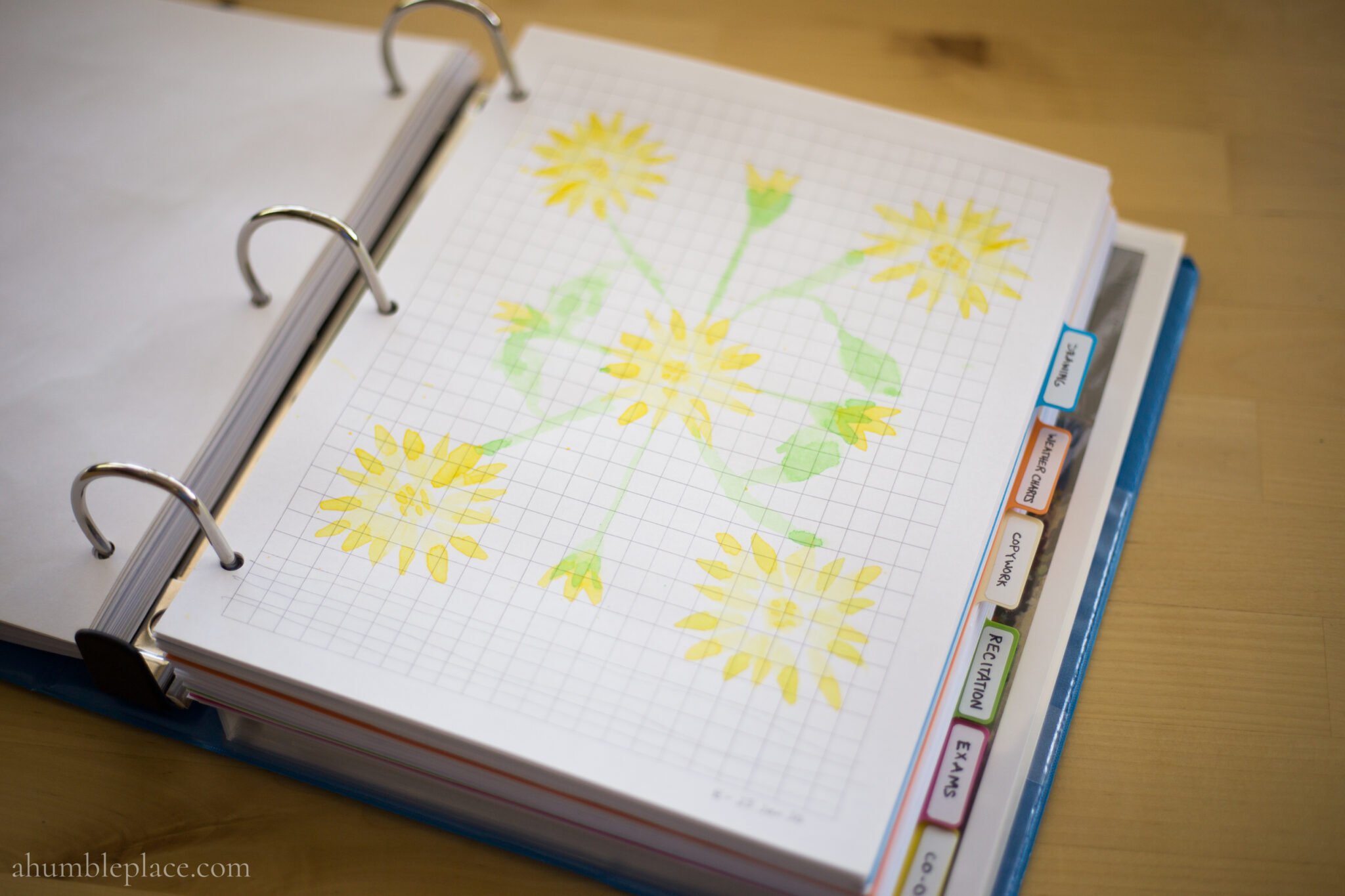
I have been putting together a homeschool year archive binder for both of my kids each school year since we began homeschooling in 2016. Today I’m sharing why you might want to create one, the supplies I use to put ours together, and how I organize everything!
First, though, do you really need a homeschool year binder?
If you don’t live in a state that requires you to submit a homeschool portfolio for review each year, you may wonder why you’d even need a homeschool year archive binder. It’s true that you don’t necessarily need one, but I have found that having this little record of our previous years is not only helpful in knowing what we went over, but it’s also a nice little time capsule of our school year. I also appreciate being able to see the progress we made in a given subject, whether it was copywork, grammar, or handicrafts.
Supplies
- Binders (I like 3-inch binders and I usually get a different color for each kid)
- Hole Punch (this one punches up to 40 sheets and works so well)
- Dividers (these are plastic, extremely durable, and come in a six-pack)
- Markers or Label Maker (for labeling the tabs)
- Sheet Protectors

What should you put in your binder?
Here are examples of the things we’ve included in our binders:
- First day of school sign
- Attendance records (when they were not in my homeschool planner)
- Umbrella school enrollment records
- Piano practice records
- Term overviews
- Calendars
- Weekly planning sheets (when they were not in my homeschool planner)
- Morning time plan sheets
- Poetry readings (printed out from AmblesideOnline)
- Copywork
- Letter-writing exercises (from Teach Your Child to Read in 100 Easy Lessons)
- Nature study exercises that didn’t go in our nature journals
- Drawing exercises
- Brushdrawing exercises
- Math sheets that needed to be removed from the math workbook
- Hymn and folksong selections
- Co-op handouts (usually covering composer study, nature study, handicrafts)
- Recitation selections
- Exam Work
- Picture study prints
I usually put anything and everything that was written down or drawn on loose paper. For example, all of our drawing exercises from What to Draw and How to Draw It were included. For copywork, I bought three packs of lined paper and when my son finishes one of those sheets or my daughter completes a sheet from worksheetworks.com, I put it in the binder. We had a few exercises in our grammar curriculum that required extra paper, so those went into the binder as well. And all of the papers handed out in our co-op can be found there also. At the end of the binders, I insert sheet protectors and put in all of the picture study prints we look at for the year. For my daughter, I took all of her origami creations and put them in sheet protectors as well.
I also keep track of administrative-type records in our binders. This includes things like attendance records (these are now part of my homeschool planner, but I used to keep them in the binders) and the official enrollment letter we get from our umbrella school at the beginning of each year. I also put in all of our term overviews (I copy the ones from AmblesideOnline into a spreadsheet and modify it to fit our needs before I print it out to use for my weekly planning) and Morning Time rotations as well. Throughout the year we also have a calendar propped up on our school table where we keep track of birthdays, co-op meetings, and other important dates and I make a copy of these calendars to put into each binder.
I also store our exams here as well. Because we’re still doing oral exams, I record our exam sessions and then transcribe their narrations later. I then print those sheets out and insert them into their own section in the binder. Another option would be to burn the recordings to a CD which can be added to the binder as well, but I’m not that organized. 
These binders are just a great place to keep all of those loose papers that accumulate throughout the year that are related to your homeschool, so it’s really up to you what you include!
What should you not put in your binder?
Honestly, there are no rules for what you can and cannot put in your binder. I have chosen not to put written work in the binder that was already in another type of bound book. For instance, all of our math worksheets, spelling exercises, and some of our grammar exercises were done in workbooks, so I have kept those separate. However, when we’re done with those books, I will store them with the binder and sometimes it’s even wide enough that I can slip them in between the cover and the first page so everything is stored together.

How should you organize your binder?
Here’s an example of how I organized my son’s Year 3 binder:
- Front pocket: first day of school sheet/random piano sheets/character cards for Shakespeare
- Administrative paperwork (umbrella school letter, term overviews, calendars, Morning Time plans)
- Hymn/Folksongs for the year (organized by date)
- Brushdrawing exercises
- Drawing exercises
- Weather charts (we studied weather for nature study that year)
- Copywork
- Recitation selections
- Exams
- Co-op
- Picture study prints (organized by date)
- Back pocket: miscellaneous piano sheets
I usually buy the binders at the beginning of the year and keep them in a cabinet in our homeschool area. Once a week I aim to put them where they belong in the binder, but often I fall behind on this so I end up doing it at the end of the term or year. I start by inserting all of the papers I want to keep in the binder, grouping them by subject, but don’t put labels on the dividers until I’m done putting all of the papers in. That way I have an idea of how many sections or dividers I’ll need and from there can determine how I split up the work. For instance, if I don’t have a lot of sections from our day-to-day school, I can split up the co-op handouts into sections (eg. we always did composter study and nature study in co-op and I could give each of those their own sections).
You also have the option of not doing sections at all, which is what I did the first few years and just kind of grouped the papers by subject, but I have found that the dividers make it a lot easier to find papers later.
It’s really a simple system for having a nice little record of each year which has been nice to have not only to check what we did in a given year, but also as a little trip down memory lane. 
The post A Homeschooler Guide to Making a Simple School Year Archive appeared first on a humble place.

